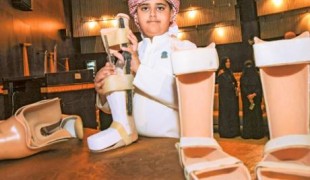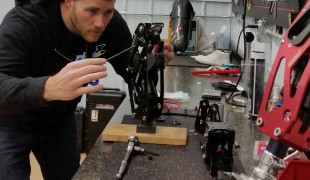- 10297
- 575
- 15
- 19
- 0
- Help Ukraine
About the solution
Amy loves life despite of her disability. To make her dreams come true, she developed several sorts of prosthesis. Initially, she created a prosthesis to practice snowboard. Later, she invented two prosthesis which allow her to dance.
Amy wanted to be free and live in a place where she could snowboard. In 1999, at age 19, she became a double amputee because of a bacterial meningitis. She was in the hospital - on life support - with less than a two percent chance of living. Over the course of two and a half months, she lost her spleen, her kidneys, the hearing in her left ear and both of her legs below the knee.
“When my parents wheeled me out of the hospital I felt like I had been pieced back together like a patchwork doll”, she recalled.
Just after she came out of hospital, she tried artificial limb.
“I thought the worst part was over until weeks later when I saw my new legs for the first time”, she said.
In fact, prosthesis were too heavy, too big, and were hurting her. These legs would not allow her to travel, and follow her dreams. But above all, these prosthesis were not appropriate for snowboarding. Amy never gave up on her passion about snowboarding, this is why she decided to make a pair herself. She did a year of research and she created - with her leg maker - prosthesis which were able to react within a thousandth of a seconds.
To make a pair of feet that she could snowboard in, they put random parts together. They used rusted bolts, rubber, wood and neon pink duct tape.
Thanks to her willpower, her family and her prosthesis, Amy became the highest ranked adaptive female snowboarder in the world, and she took the third place in the Paralympics games in Sochi.
In 2014, after the paralympics games, Amy participated to the eighteenth season of "Dancing with the Stars", a TV show where celebrities have to dance. Once again, her leg maker helped the star to be fitted with special prosthetics for her" Dancing with the Stars" performances. For this special event, she made two different types of prosthesis.
The first one, called “Runway”, which allowed Amy to wear high heels while providing the dynamic flexibility she needed for the performances in the TV show. The second one, called “Nitro”, which gave her the bounce and lightning fast energy return she needed for specific dance such as the Quick Step.
Thanks to these legs, Amy was able to follow her dreams again.
Adapted from: http://bit.ly/2qvG2C2
This solution shall not include mention to the use of drugs, chemicals or biologicals (including food); invasive devices; offensive, commercial or inherently dangerous content. This solution was not medically validated. Proceed with caution! If you have any doubts, please consult with a health professional.
DISCLAIMER: This story was written by someone who is not the author of the solution, therefore please be advised that, although it was written with the utmost respect for the innovation and the innovator, there can be some incorrect statements. If you find any errors please contact the patient Innovation team via info@patient-innovation.com
-
-
583
-
0
-
9392

Boy creates waterproof lightweight prosthetic leg
-
-
-
576
-
0
-
10540

Amputee develops prosthetic leg
Snowboarding
Driving
Cycling
Limb Amputation
Limb Deformity
Prosthesis
Assistive Daily Life Device (to help ADL)
Muscle weakness
Limited range of motion
Reduced grip force (grip)
Loss of muscle coordination
Muscle cramps or spasms
Restoring mobility
Replacing lost limbs
Promoting self-management
Promoting inclusivity and social integration
Preventing (Vaccination, Protection, Falls, Research/Mapping)
Orthopedics
United States
-
-
-
706
-
0
-
9256

Former wheelchair user creates open source wheelchair
WALKING WITH A WALKING AID: Walking with a walking aid
Post-Polio Syndrome
Muscular Dystrophy
Neuromuscular Disorders
Cerebral Palsy
Cervical spinal cord injury/Tetraplegia
Walking Aid (wheelchair/walker/crutches)
Assistive Daily Life Device (to help ADL)
Muscle cramps or spasms
Difficulty coordinating movements
Stiffness or rigidity (difficulty moving)
Paralysis of the legs and lower body
Muscle weakness
Restoring mobility
Promoting self-management
Managing Neurological Disorders
Maintaining Balance and Mobility
Preventing (Vaccination, Protection, Falls, Research/Mapping)
General and Family Medicine
Infectious Diseases
Medical Genetics
Neurology
Orthopedics
Public Health
Kenya
-
 en
en